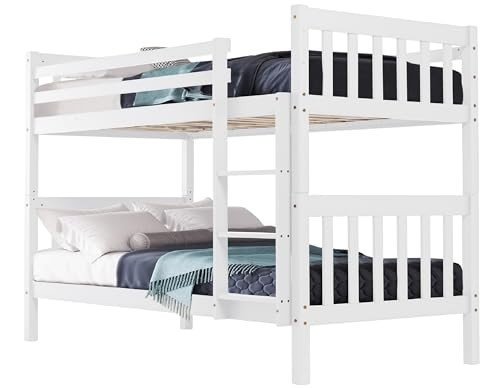18
mayo10 Things We All Were Hate About Bunk Beds
Exploring Bunk Beds: A Comprehensive Guide
Bunk beds have long been a staple in kids's bed rooms, dormitories, and even homes with minimal space. Not just do they offer a practical sleeping service, but they likewise create a fun and imaginative environment for children and a great space-saver for adults and families. This short article will explore everything you require to understand about bunk beds, from types and materials to safety tips and buying advice.

Tabulation
- Types of Bunk Beds
- Conventional Bunk Beds
- Loft Beds
- Triple Bunk Beds
- L-Shaped Bunk bed for adults uk Beds
- Product Options
- Wood
- Metal
- Safety Considerations
- Purchasing Guide
- Frequently asked questions
Types of Bunk Beds
Bunk beds can be found in different designs to suit various needs and preferences. Here's a breakdown of the most typical types:
Conventional Bunk Beds
Traditional bunks typically feature 2 beds stacked vertically on top of one another. These beds are ideal for brother or sisters sharing a room or for maximizing sleeping space in visitor rooms.
Loft Beds
Loft beds stand likewise to conventional bunk beds for adults uk beds however do not have a lower sleeping location. Rather, they frequently integrate a desk or seating location below, making them a great choice for small rooms requiring multifunctionality.
Triple Bunk Beds
Triple bunk beds are developed for three residents, with beds stacked in a three-tier setup. These are less common however can be an enjoyable solution for big households or sleepovers.
L-Shaped Bunk Beds
With one bed placed horizontally and the other vertically, L-shaped bunk beds are typically equipped with extra features such as desks or storage drawers and can match corner areas in a room.
Comparison of Bunk Bed Types
| Bed Type | Suitable Use | Description |
|---|---|---|
| Traditional | Shared bedrooms or guest spaces | Two beds stacked vertically |
| Loft | Little spaces needing multi-purpose space | Upper bed with open space underneath |
| Triple | Big families or pajama parties | Three beds stacked vertically |
| L-Shaped | Corner or flexible areas | A mix of vertical and horizontal beds |
Product Options
Bunk beds are made from different products, with wood and metal being the most typical. Each material has its benefits and drawbacks.
Wood
- Durability: Generally robust and can stand up to years of use.
- Visual Appeal: Offers a timeless appearance that can blend with different decorations.
- Weight Capacity: Typically sturdier; can support heavier weights.
- Downsides: May be more pricey than metal choices and can be prone to scratches.
Metal
- Strength: Generally lightweight and simple to move but still tough.
- Modern Design: Often is available in streamlined styles, making it appealing for contemporary areas.
- Affordable: Usually cheaper than wood options.
- Downsides: Can be cold to the touch in winter seasons and may not have the exact same visual appeal for some purchasers.
Safety Considerations
When it pertains to bunk beds, security can not be neglected. Here are crucial safety pointers to keep in mind:
- Guardrails: Ensure that the top bunk has guardrails on both sides to avoid falls.
- Strong Construction: Check for a strong build and strong products to hold up against weight and movement.
- Weight Limit: Adhere to the maker's weight limitation for both the upper and lower bunks.
- Ladder Design: Choose bunks with a safe, easy-to-climb ladder and prevent any sharp edges or rungs.
- Age Restrictions: Most makers advise that kids under the age of 6 must not oversleep the upper bunk.
Buying Guide
When shopping for bunk beds, consider the list below elements to discover the best fit for your requirements:
- Space Availability: Measure the room size and ceiling height, ensuring there is adequate space for the leading bunk.
- Bed Size: Decide between twin, full, or larger sizes based on your requirements and the size of the space.
- Style Preference: Consider the general decor of the bedroom to find a suitable design.
- Reduce of Setup: Look for a bunk bed that is simple to assemble.
- Budget plan:bunk beds for teens beds come in various rate varieties, so identify a budget plan before beginning your search.
FAQs
1. What is the recommended age for kids to sleep on the top bunk?
Kids aged six and older are typically recommended to sleep on the leading bunk to minimize the risk of falls.
2. How can I make my bunk bed more secure?
To enhance safety, guarantee guardrails are correctly installed and inspect that the bed is put on a flat surface. In addition, encourage children to use the ladder carefully.
3. Can I transform a bunk bed into two separate beds?
Lots of bunk beds are designed to be convertible. Examine the maker's requirements for convertibility features.
4. What devices are available for bunk beds?
Common accessories include beddings, storage drawers, staircases rather of ladders, and tented canopies for an enjoyable visual appeal.
5. How do I maintain my bunk bed?
Regular look for loose screws or structural stability can help make sure safety. Dust the bed routinely and clean spills promptly to keep the materials in good condition.
Bunk beds are versatile and a space-efficient option for numerous living situations, from kids's spaces to guest lodgings. With numerous styles and materials readily available, possible purchasers have a wealth of alternatives to think about, ensuring a mix of usefulness and looks. By prioritizing security and following the ideas described in this guide, people can find the best bunk beds for adults bed that matches their space and lifestyle, all while developing a pleasurable sleeping environment.


Reviews